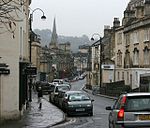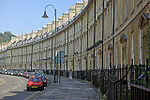Cleveland Bridge
1826 establishments in EnglandBridges across the River Avon, BristolBridges completed in 1826Bridges in SomersetFormer toll bridges in England ... and 3 more
Grade II* listed bridges in EnglandGrade II* listed buildings in Bath, SomersetUse British English from May 2015

Cleveland Bridge over the River Avon is a grade II* listed building located in the World Heritage Site of Bath, England. It is notable for the unusual lodges that adorn each corner in a style that could be likened to miniature Greek temples.
Excerpt from the Wikipedia article Cleveland Bridge (License: CC BY-SA 3.0, Authors, Images).Cleveland Bridge
Cleveland Place, Bath Walcot
Geographical coordinates (GPS) Address External links Nearby Places Show on map
Geographical coordinates (GPS)
| Latitude | Longitude |
|---|---|
| N 51.389444444444 ° | E -2.3558333333333 ° |
Address
Cleveland Bridge
Cleveland Place
BA1 5DH Bath, Walcot
England, United Kingdom
Open on Google Maps










